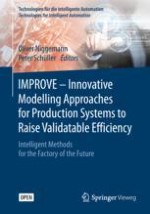Open Access 2018 | Open Access | Buch

IMPROVE - Innovative Modelling Approaches for Production Systems to Raise Validatable Efficiency
Intelligent Methods for the Factory of the Future
herausgegeben von: Prof. Dr. Oliver Niggemann, Dr. Peter Schüller
Verlag: Springer Berlin Heidelberg
Buchreihe : Technologien für die intelligente Automation